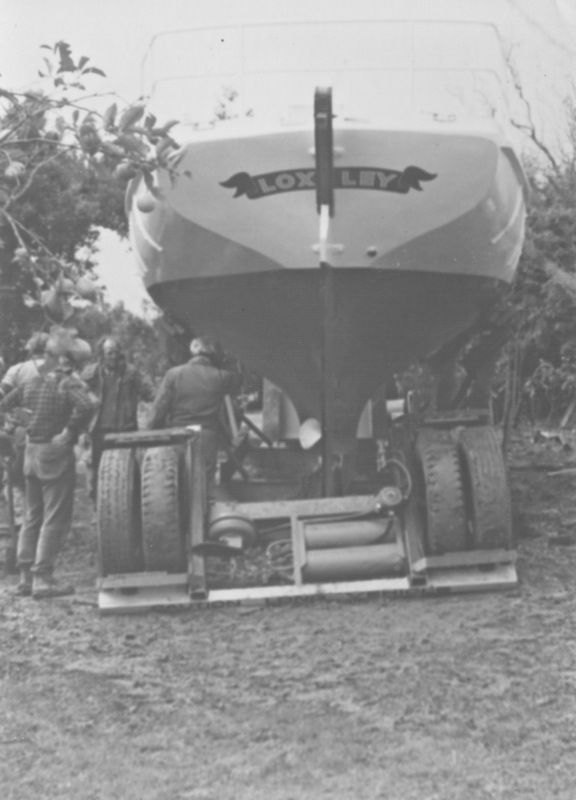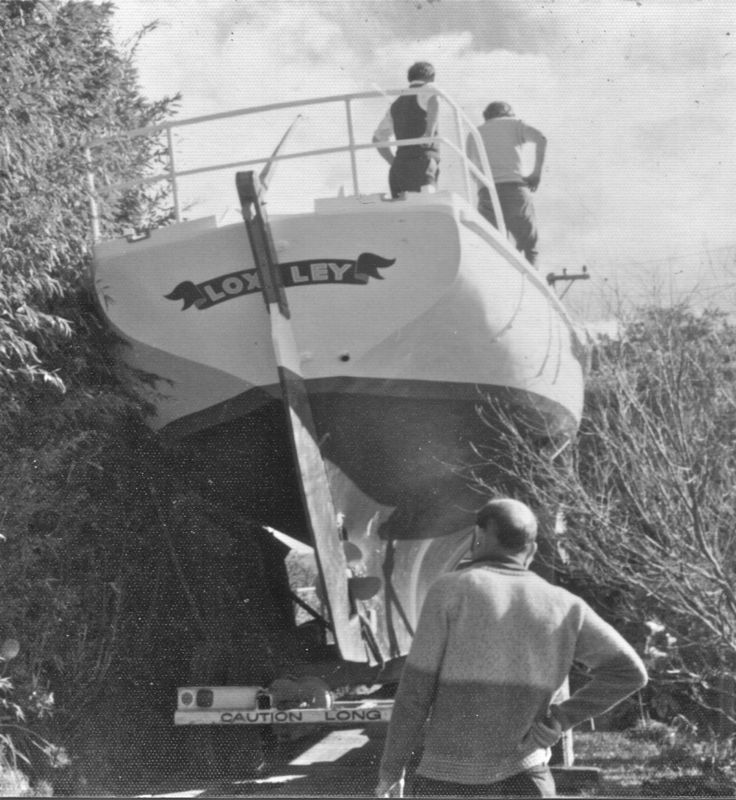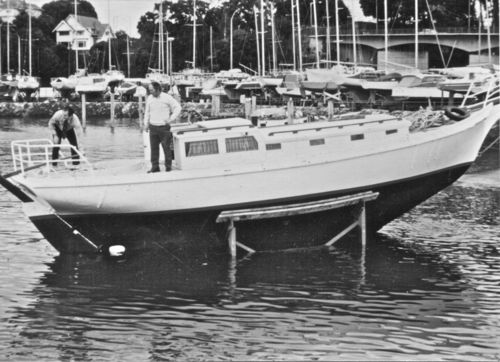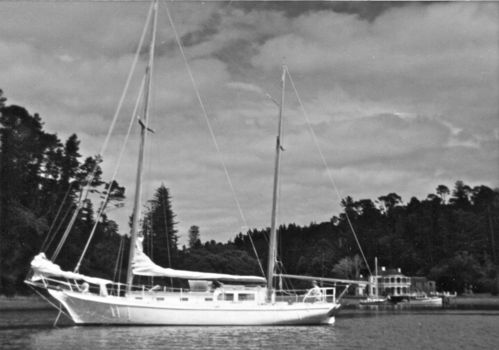About forty-three years ago, when I was a mere 55-year-old lad, I was fishing off Red Mercury Island in a cabin motorcruiser that I’d built. A fairly large yacht came slipping past quite close to us, very peaceful and quiet, and I said to my son, Graeme, “That is what we should have.” That decided me on building what eventually became ‘Loxley’ a 37-foot ketch.
At the time I was thinking about building Loxley, some members and boat designers of the Ferrocement Association were offering advice to people who were interested in this type of construction. It seemed to be a much simpler and cheaper approach than the traditional wooden boat-building that I’d done before, and so I decided to join the club to learn about ferrocement before I committed myself to doing another build in wood.
Ferrocement construction was a completely revolutionary concept at that time, but history shows it as a very short-lived blip in boat-building fashion, that would soon be overtaken by low-cost GRP methods. Nevertheless, it seems to me that someone should write about the history of a ferrocement build in New Zealand, and Russell Brown has been kind enough to give me a little space on his website to tell you my story (and a little break from thinking about the election).
At any rate, swept up in revolutionary fever, I eventually decided to build a Herreshoff design, called ’Nereia’ in ferrocement instead of wood. It was necessary to make several modifications to the design to allow for the difference in the construction. One of the boat designers in the club advised me what to do – for example, I was using cast iron billets for ballast instead of lead, so he pointed out that I needed to widen the keel six inches at the centre to allow room for more cast-iron to be used to make up the required weight. Several of these designs had already been built in ferrocement and were very successful.
I purchased a set of plans. They were extremely detailed, covering everything including the sail plan and masts. But it was a daunting moment looking at those sheets of paper and thinking about turning them into an actual boat. I remember thinking to myself: now where does one start?
I began the process of building the boat according to the advice of the Ferrocement Association, but despite my exhaustive labours nothing much appeared to be happening for a long time. However when the hull started to take shape I suddenly had a great many visitors coming to look at Loxley. A lot of them wanted to know if they could help me in any way, and many of them did and were very useful. Some of them were particularly interested in the construction of the boat, and watched it develop and came back many times. We ended as quite good friends.
Ferrocement construction consists of building a rough wooden skeleton mould of the yacht. To this is attached a framework of six millimetre reinforcement steel, horizontally at two inches centres, and diagonally at four inches centres. Four layers of galvanized half-inch chicken netting is placed each side of the steel reinforcing, then tied together very tightly with steel wire. All of this sits on a half-inch thick plate of steel cut to the shape of the keel, and reaching about three feet up the stem. Plastered with special cement, the finished thickness of Loxley’s hull was less than an inch.
A specialist plasterer must be used for ferrocement boats. The plasterer that ended up doing Loxley had previously plastered 29 boats before ours. It was very exciting when the day finally came to plaster it. We had a lot of helpers and family all doing their task or watching. Even Garth Tapper (the famous portrait painter) came along to help.
We all watched it develop from a mass of steel into a lovely yacht. It had to be covered so that the plaster didn’t dry out, and I kept it hosed down and wet all the time for a week so as to cure the cement. I plastered the inside of the boat myself. This was just filling the inside plaster work and covering all the steel work – so I converted an old vibrating sander into a wooden plastering trowel. It was a wonderful tool and made the job very easy, producing an excellent finish.

Above: Lifting Loxley onto the transport trailer.
The decks and cabin sides were the next thing, and when the cement was cured I installed the wooden bulkheads that give rigidity to the whole yacht. There was still a lot of work to do, as all I really had was a bare shell. The experts advised me to keep as much weight off as I could above the waterline. By the time the hull had hardened I was able to install the ballast and the large steel tanks: one for diesel and the other for drinking water.
It was now watertight, so I could start work on the inside, and fit the diesel engine in place. I had found a firm in Leeds that were converting new Ferguson diesel tractor engines for marine use by fitting a marine gearbox with the controls. They were 32 horsepower and most suitable for my boat. I lodged the money with my bank, and they wrote to the firm and said that when they got the Bill of Lading and the engine was on board the ship, they would forward my payment.
When it finally arrived in New Zealand, my wife’s brother – who was a Custom Agent at that time – arranged for a carrier to deliver it to me as soon as it came off the ship. I was so pleased with it when it arrived, and couldn’t wait to start it. We put the engine oil in and some diesel fuel then fired it up. It sounded great.
It was time to get the masts made and put the order in for the timber. I was lucky that the Odlin’s Timber Company Manager understood that it had to be first-class timber. He got his men to select all the timber for the masts from a new shipment of Oregon pine that had just arrived. They selected beautiful faultless straight-grained timber, and then cut it to the selected sizes for both masts. Building masts is a specialized trade and was beyond my capabilities – so I got professional mast-maker to make them and they did a wonderful job.
There was still a tremendous amount of work in the masts for me after they were delivered. There are so many fittings, pulleys, cleats, etc. attached to them, and I had to get them all made by the local welder and then galvanized.
I think the welder got so sick of the sight of seeing me that he must have felt like shutting the door and pretending he was closed. But he made them all for me, and after I had varnished the masts with many coats of polyurethane, they were at last ready to step into the boat.
Loxley was eventually ready for launching in 1974; we were lucky to find a safe mooring on the Wade River, which is just north of Auckland. It had taken me four years of my spare time to build her, but I had thoroughly enjoyed it and was now looking forward to enjoying some sailing.
I got in touch with a man called Logan, who was an expert at moving yachts this size. The designer estimated it to weigh 12 tons (if it were built in wood) including five tons of ballast. Because it was designed with a lot of buoyancy it needed to be this heavy, but we did not know how much this boat weighed in ferrocement. However when it was all complete with masts and everything – much to everyone’s surprise – it floated exactly on the designed water line.

Above: Manoeuvring Loxley up the driveway.
I live at the bottom of a long drive, which is only 10 feet wide and with two power poles close to the fence – and Loxley was 11’4” wide at deck level. Just before the boat-movers were due it rained for seven days, and the ground became saturated. Loxley didn’t seem to want to leave us; she became stuck in the mud. It took us four days to get her out. Eventually a giant bulldozer with a hefty winch was procured and hauled Loxley onto hard ground with sheer brute force.

Above: Loxley about to be launched at Westhaven (with me standing on the deck just behind the bowsprit).
We leaned her over in the cradle to one side to miss the poles and finally got her parked on the road. What a relief to see her there. It took ten years off my life getting it safely out of the mud and onto the road at the end of our driveway. At the launching ramp at Westhaven Marina, my daughter, Briar, officially christened my new boat as ‘Loxley’.

Above: Loxley about to leave the cradle.
The launching was perfect and Loxley slipped into the water and floated like a swan. The masts were so long that I wondered how I could get them to Westhaven. The manager from Odlins Timber came to my help and said that he would pick them up from my house, and take them down to the boat for me the next time he was taking a truckload of timber that way. The mainmast was very long; the mizzenmast was somewhat shorter. We placed both masts on top of some long timber that he was delivering, and he took them down to Westhaven and placed them alongside the launching pad for me.
I was lucky that I was able to hire a mooring for a few weeks, and make use of all the facilities of Westhaven Marina for stepping the masts. I stayed them temporarily with fencing wire so that we could measure the length of the shrouds and stays. John Burns’ marine section made the rigging for me and I fitted the items in their places, one at a time. Better still, my wife and I could live and sleep on the yacht while we finished the rigging. It was lovely, so different, just like another world for us. A dance band across the harbour played in the still of the night:
Baby Blue, Baby Blue, do you know,
I’m still in love with, you-oo...
We didn’t mind the noise as it fitted our mood and we were so cosy and warm, nicely tucked up in our comfy double-bunk. The cabin was nice too, I had lined the inside with oak marine plywood – and with sparkling new paint, varnish and upholstery it looked really good.
I just bought the working sails for a start. So now it was time for our first sail, and to see how Loxley got on with sailing. Of course we could always use the diesel engine as a last resort.
Having built the yacht I knew it from stem to stern. My son, Graeme, and I decided to motor into the main harbour then we could sail straight down the Waitemata where we had plenty of space. Neither of us had ever sailed anything before, but then I had never built a 37-foot yacht before either.
So we started the engine, cast off and worked our way into the harbour, hoisted the mainsail and Loxley sailed away. She was happy in the sea, that was obviously where she belonged and we were surprised how easy she was to handle. I knew that I had a good sea boat, and that once we got to know one another better we would get on very well together. What a wonderful feeling it was for me; the culmination of four years hard work into a boat that seemed to have suddenly come alive beneath my feet.

Above: Loxley fully rigged.
The time ran out for our hired mooring. We had to get out of Westhaven and go to our pile mooring in the Wade River. It was a good safe mooring but quite a bit further away by road. We sailed Loxley there and moored her without any trouble. Somewhere to moor boats in Auckland was a big problem for all boaties, so in a way we felt lucky to be there. We joined the Weiti Yacht Club that owned the moorings on the Wade River.
It was 1974, I would be 60 years of age in two years’ time and I thought that if I could retire then we would have the time to enjoy sailing Loxley, and do a lot of things that we had always wanted to do, but never had the time. My wife and I were still comparatively young, and both fit and well.
It seemed to me that I had spent most of my life working. I started my working life the day I left school at 14 years of age. Now I felt as though it was time to take it easy, and for my wife and I to start enjoying our retirement years. You were entitled to superannuation at 65 years of age at that time, and so I thought I would have to work a little longer before it could happen.
A General Election was due and the leader of the National Party was Robert Muldoon, a politician whom I particularly hated. He promised to bring in universal superannuation payments at 60 years of age if his party were elected. He won the election, brought in the legislation, and it passed in parliament just before I was 60 years old. Thank you very much Mr Muldoon! I received my first payment a week after the Christmas following my 60th birthday.
So now my wife and I could retire and begin to enjoy the rest of our days together and live some of our dreams. That was all a long time ago, and in our later years we enjoyed a very happy and wonderful retirement with many years of sailing in our lovely little ferrocement boat.


